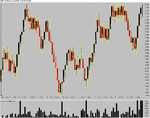Acrary: If you had to do it all over again....
With the info I have now, I would've done things very differently.
I would trade 100% strategic and 0% tactical. By this, I mean I would diversify simple trading styles like trend, countertrend and rangebound over time and markets. I wasted too much time and effort on when to buy and when to sell. My time would've been better served asking; "should I be long, short, or flat?", for the simple strategies in multiple timeframes and markets.
Rather than compounding I would add more timeframes or markets to build the account while continually lowering the overall risk.
Yes, I've fooled myself with the "perception is reality" argument.
My work with my model on immunologic response has forced me to completely change my views on the markets. I used to think the markets were mostly random and chaotic with periods of stable recurring predictability. I couldn't prove this theory because I hadn't come up with a really good way of segmenting market movements and the sample sizes were always statistically small. This was my perception ... and I acted on it so it must have been my reality.
I quickly realized if I wanted to come up to speed on immunologic work I'd have to abandon pattern matching and concentrate on letting the algo work on finding the best strategy for a market. To do this I built a handful of basic strategies and forced the market activity into a time box (1 day, 2 days, etc.). I then used the model (I call it Doron) to determine which of the available strategies should be used for the market in the time period. Anytime a large losing period was found I'd look at the data and determine that I didn't have a strategy for the model to use. So I'd code up a new simple strategy for it to sample (much like your immune system getting fooled the first time it faces a new disease...sample it...become resistant to future occurrences).
In short what I found was a handful of simple strategies in a couple of markets were just as effective as all the years of work I did on finding market inefficiencies, measuring them, and exploiting them with tight edges. I had to give up my basic market premise and now go with "the markets are mostly inefficient and chaotic with small periods of stable predictability but with large periods of stable recurring strategic themes."
In short, at 50 I feel like an old fool. Squandering my time trying to figure out the optimal way to fish in a pond when all I had to do was turn my back and throw out my line into a ocean full of opportunities. Maybe some 20 something will learn something from this and not waste his life like I have with the false perceptions I bought into. Our perceptions are indeed our reality.
If you accept the first case you have to believe there is a high signal to noise ratio. Because of this, the opportunities for consistent profitability would appear as islands of opportunity in a sea of randomness. It would require large, indepth study to locate the islands and large periods where you wouldn't trade.
In the second case the markets are non-random but ever changing along the lines of themes (large trending periods, large chop periods, large counter-trend periods, etc.). In this case all you have to do is determine what large periods occur in a market and put in a strategy to exploit the opportunity as it comes around. No need to worry about randomness. Just define the dominant strategies in a market and do the basics like let profits run...cut losses short and let the strategies play out over time.
Huge difference in scalability between the two.
No, what I'm saying is in case 2 all you need to do is determine the themes, apply normal trade management skills, and diversify in time, approaches, and markets to control losses. I didn't think I could achieve superior results this way and thought it would end up like the one dimension long term trend followers that suffer through long and deep drawdowns. What I've found is you get the benefits of case 1 and the scalability of long term trend traders without having to pay in terms of deep drawdowns. No need to switch between themes. Cut losses short if a primary theme becomes secondary and let the secondary that becomes primary give you your profits. Not very exciting...but very rewarding. No prediction necessary.
Lets say a market has two primary characteristics; trend and bounce off support/resistance on a daytrading basis. The market opens and starts to drop. You enter a short following the trend. The market goes down to a support level, stalls and starts to reverse. The support model kicks in a long trade. Meanwhile the trend model is far enough ahead that the stop is moved to breakeven. The market continues up and ends the day near a old high (resistance). In this case you brokeven on the trend trade by using common trade management. The bounce trade made a good profit. No bias was taken because you would've made money if the market blew through support and the bounce trade was stopped out. That's all I'm saying.
Don't use a bias. Trade both. Keep capital allocations per-trade small and let the more frequent trading compound the account.

